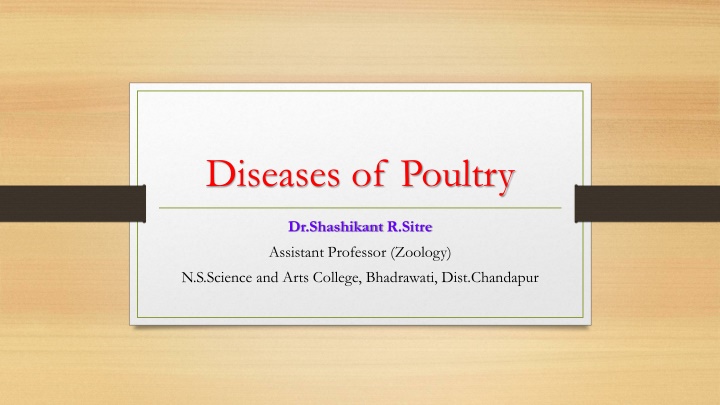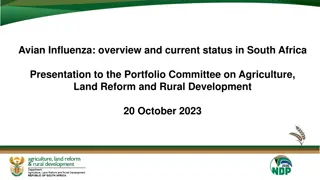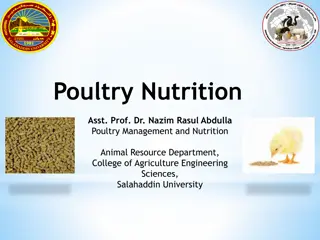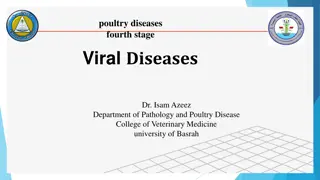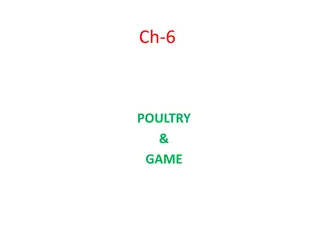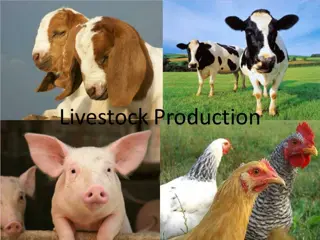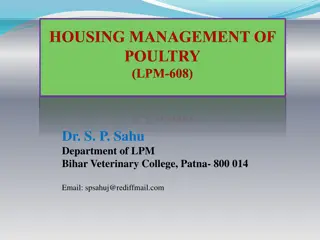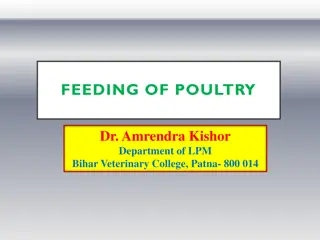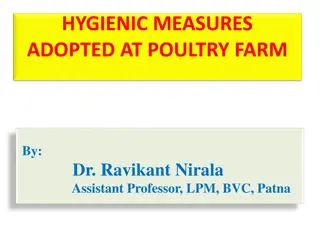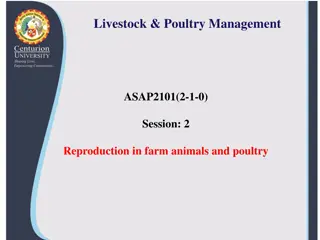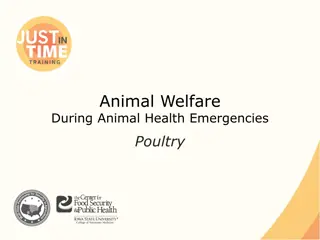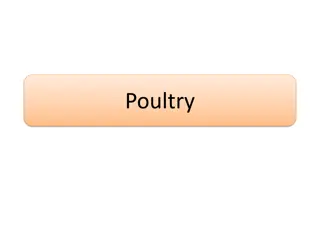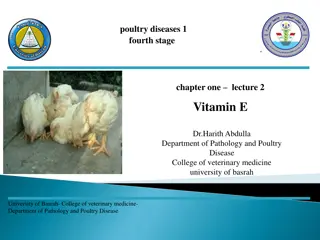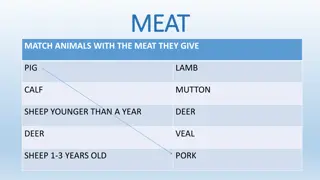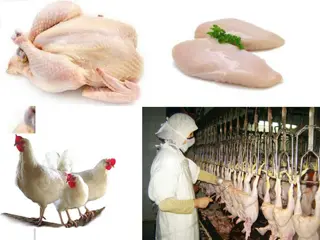Overview of Poultry Diseases and their Causes
Poultry diseases caused by viruses and bacteria are a significant concern for poultry farmers. Viral diseases like Ranikhet Disease, Fowl Pox, and Avian Leucosis can have high mortality rates and severe symptoms. Bacterial diseases such as Tick Fever, Tuberculosis, Fowl Cholera, and Infectious Coryza also pose serious threats to poultry health. Understanding the symptoms and treatments for these diseases is crucial for effectively managing poultry health and preventing outbreaks.
Download Presentation

Please find below an Image/Link to download the presentation.
The content on the website is provided AS IS for your information and personal use only. It may not be sold, licensed, or shared on other websites without obtaining consent from the author.If you encounter any issues during the download, it is possible that the publisher has removed the file from their server.
You are allowed to download the files provided on this website for personal or commercial use, subject to the condition that they are used lawfully. All files are the property of their respective owners.
The content on the website is provided AS IS for your information and personal use only. It may not be sold, licensed, or shared on other websites without obtaining consent from the author.
E N D
Presentation Transcript
Diseases of Poultry Dr.Shashikant R.Sitre Assistant Professor (Zoology) N.S.Science and Arts College, Bhadrawati, Dist.Chandapur
Viral Diseases of Poultry 1. Ranikhet Disease 2. Fowl Pox 3. Avian Leucosis
Viral Diseases 1. Ranikhet Disease It is a highly infectious disease with 80-100% mortality rate. It is caused by virus. The symptoms are sleepiness, droopiness, loss of appetite, difficulty in breathing, green diarrhoea, coughing and sneezing and death by paralysis.
Fowl Pox It is a viral infection and is very contagious. Young birds are more susceptible to this disease and the mortality rate is almost 100%. The symptoms of this disease are wart like protuberances on comb and wattles. The eyes and nostrils often become covered by yellow, cheesy discharge which sometimes causes respiratory trouble. There is no effective treatment for this disease.
Avian Leucosis It is caused by viral infection and is supposed to be an important disease. The symptoms depend upon the parts affected by this disease. In general death occurs due to paralysis and heart failure. There effective treatment for this disease. is no
Poultry Diseases caused by Bacteria 1. Tick Fever or Spirochetosis 2. Tuberculosis 3. Fowl Cholera 4. Infectious Coryza
Bacterial Diseases 1. Tick Fever or Spirochetosis It is a highly fatal disease caused by n organism called Borrelia gallinarum. The fowl tick Argus persicus is the transmitting agent from one bird to Symptoms are rise in temperatue and a subsequent sudden drop below normal, loss of appetite, increased thirst, profuse loose discharge etc. In advanced condition paralysis of legs and wings occurs and the birds die within 24-48 hours of appearance of these symptoms. Mortality rate is 70- 100%. Affected bird will be injected with soamin and sulphursenol in 2cg and 1cg ratio per kg. of body weight. another.
Tuberculosis This infectious disease is Caused by bacteriusm microbacterium tuberculosis. The symptoms are loss of body muscles. Paralysis of legs occurs at acute stage. Thee is no treatment and the affected birds should be isolated .
Infectious Coryza This disease caused by Haemophilus gallinerum and PLO germs. The symptoms are inflammation of the head sinus and respiratory passage leading to respiratory problem. The birds show inactivity, coughing and sneezing. There is neither any treatment nor any effective preventive medicine for this disease.
Fowl Cholera It is caused by a bacteria Pasturella ariseptica. Symptoms are diarrhoea, weakness etc. Sulphamezathine (16%) is administered.
Poultry Diseases Caused by Protozoa 1. Coccidiosis
Coccidiosis caused by Protozoa Coccidosis is caused by group of Protozoan parasites called Coccidian. Two important members of this group namely Eimeria lenella and Eimeria mitis affect caeca and anterior portion of the small intestine respectively. The symptoms are droppings containing oocysts of coccidian, bloody diarrhoea, general weakness, loss of appetite, increasing thirst and scattered feathers. Paralysis of wings may occur. Treatment % mixture of sulphamerazathene and sulphaquinoxaline with drinking water for a about a week.
